22.07.2020
Which side are you on? or The die has been cast*
Visual arts
“This is what we’ve waited for
This is it, boys, this is war
The president is on the line
As ninety-nine red balloons go by
Everyone’s a super hero
Everyone’s a captain Kirk
With orders to identify
To clarify and classify
If I could find a souvenir
Just to prove the world was here”[1]
Born in 1987, two years before the fall of the Iron Curtain, in Soviet Ukraine, Alexandra/Sasha Streshna moved to Athens, Greece at the age of 11. It shouldn’t therefore come as a surprise that Streshna is haunted by grand historical narratives. What role have they played in western history? How have they been formulated in the realm of art? How do they affect the people that are directed to enact and consume them? What can and should be accepted as real and what as construction? Streshna’s oil on canvas figurative representations follow the tradition of western painting while depictions of battles, violence and authority are the central recurring themes in her research and her artistic process. Her paintings often reference the typical war scenes that can be found hanging in all important museums around the world. Her original starting point, however, has an unexpected twist that render the works far more complex than their predecessors. Streshna captures the zeitgeist of today’s comprehension of notions of power and their contemporary mutations.
The instrumentalization of history and the process of identity-building through national narratives of heroism and strategic regressions between victimization and hegemony are concepts interspersed in Streshna’s works. The allegorical imagery she appropriates reveals an underlying David and Goliath moral of good and bad while suggesting that the unspoken, is what unveils a more intricate and far more comprehensive portrait of the past. This is Streshna’s way of challenging the idea of the grand narrative, the carefully edited and meticulously crafted latticework of what has been. The intention is to showcase a frustration with or disappointment in the collapse of a single universal truth which most of us have been raised to believe in. This entails a loss of faith in institutional values such as the historical narrative that is reminiscent of the theory of French philosopher Jean-François Lyotard in The Postmodern Condition: A Report on Knowledge (1979). Lyotard argues that since World War II, personal micronarratives have replaced the grand narrative as a means of understanding social shifts and politics precisely because the truth seems to be increasingly debatable. He suggests that the loss of faith brought about by the collapse of grand narratives has led to the challenge of scientific knowledge, that can only become legitimate again if transformed into computer data, or potentially even pixels on a video game monitor.
After Streshna completed her MA at Central St. Martins she embarked on a series of paintings, entitled Charles, 2012–14. The original reference were pages from 1970s soviet school world history textbooks. These, as in fact all high school history lessons, are a storytelling tool that apart from educating, aim to build and reinforce national identity. Streshna selects and crops certain illustrations and reproduces them in a painterly technique that is meant to obscure the original event they depict, challenging the validity of the grand historical narrative that they were originally telling. Thus, the mechanism of collective memory-building is transformed into an activity of personal deconstruction and self-imposed amnesia. The tools so often connected to memorization and mindless repetition, are transformed into obfuscation mechanisms. The titles of the works reference the events so abstractly that it would require a compulsive need to get to the truth to understand what they depict. In fact, even the artist’s title-giving process is an act of discombobulation including works such as К оружию!, 2014, Radioactivität, 2013 and Malocher, 2014 which only obscurely reference events and notions studied in history, as taught within the Soviet Union. In her work, 1775, 2012 a blurry image of a horseback monument, most likely a military figure, surrounded by a crowd that seems to be rioting could be a nod to the Pugachev-Cossack Rebellion against Catherine the Great that took place in the Russian Empire in the entitled year. Herero, 2012 is potentially a work concerning the German-Herero conflict between 1904–1907 following Germany’s colonial attack in South West Africa and the subsequent extermination of 75% of the Herero population. However, these can only be a viewer’s guesses as the artist is uninterested in offering any further explanation on her depictions as that would defeat the purpose of her intention, camouflaging the depicted events. During this time, Streshna received for her painting the first of many awards, scholarships and accolades by the, particularly appropriate, Athens War Museum. It was followed by the Charles Oulmont Award, a short list for the Griffin Art Prize, the Spyropoulos Foundation Young Artist Award, the apexart NYC Foundation exhibition organizer grant, the Neon Curatorial exchange program and, until now, the Artworks Fellowship.
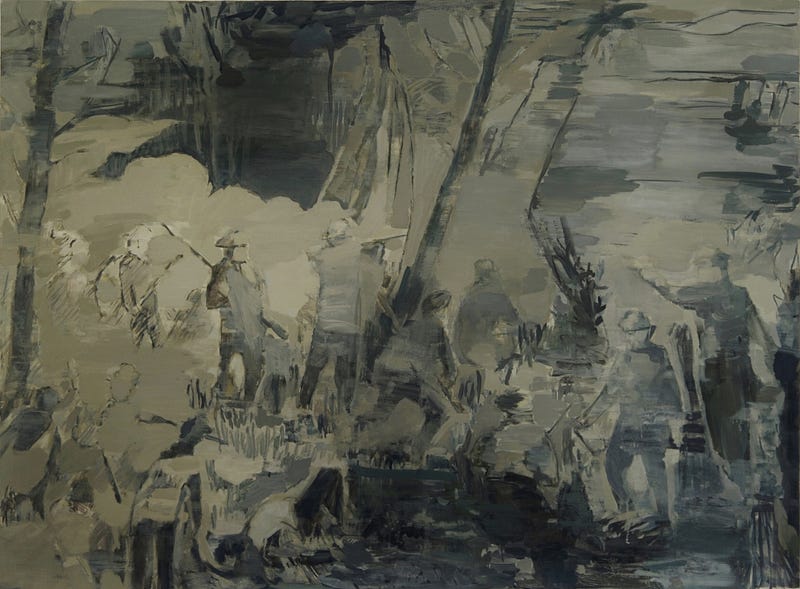
In Streshna’s painting, text of various languages is often included on the canvas itself in various forms. Either as a reproduction of the book texts or cropped captions of the original illustrations or even as her own painterly addition of words. Never consistent in language, Streshna utilizes text almost as a reminder that languages from other nations might be telling a known story differently or even an entirely unknown story that seems to have been lost in translation. Born into one language and being raised in another, such as Streshna, creates a particularly unique circumstance of dissociation between thinking and uttering. Not as easily compartmentalized as traditional bilingualism, it pertains that one is connected to a specific language, thus culture, as native in one stage of life and cognitive development and to a different one in another. Such a trajectory initially confuses but also enrichens one’s sense of belonging, consequently one’s national and cultural identity. It is therefore an in-between state in which communication becomes loaded with a philosophical quest for the authenticity of subjectivity. As Gerhard Richter says: The first impulse towards painting stems from the need to communicate:”[2].
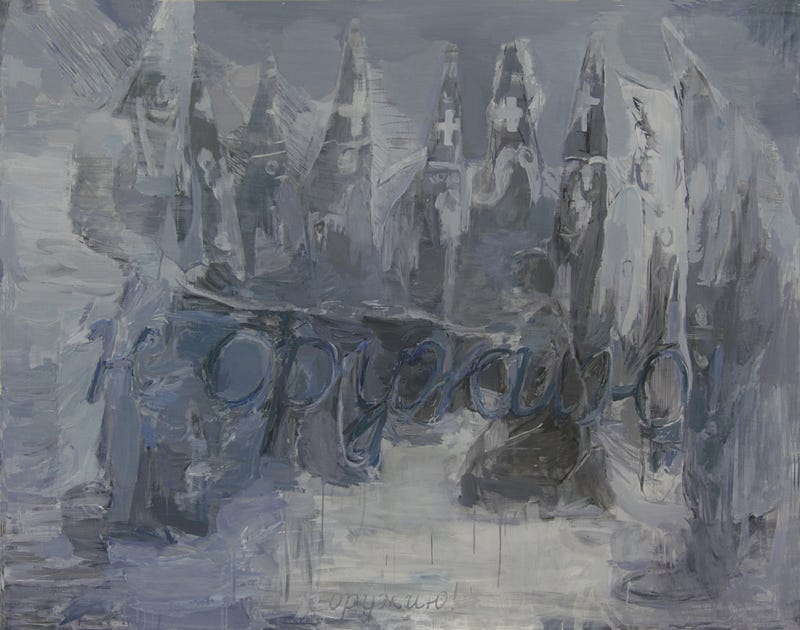
In the following years, between 2015 and 2018, Streshna focused on two series of works entitled Dark Age and Iconic. Loyal to her preoccupation with grand historical narratives, she embarked on a depiction of the Pergamon Altar’s frieze that illustrates the gigantomachy battle between the gods of Olympus and giants. Her painterly process involved painting the canvas over and over again for a long period of time until even the artist herself had forgotten what the original image reference had been. Almost as if to test herself if even she could forget the histories and myths that had forged her and were finding their way onto her canvases. The completed paintings are extremely thick-layered but ultimately abstract, while the original depiction has been beaten to obscurity by her brushes and hidden behind a seemingly sculptural plane of oil. Streshna named these works after irrelevant phrases that sound almost comical as viewers struggles to see in the painting what the title tells them to. In Iconic, the artist tackles quintessential themes of western painting such as the nativity scene, the Ascension and the birth of Venus. Her original art historical references are once again barely detected in the painting and the titles only slyly imply, if that, their origin. Once again, the audience is left wondering on the distance between title-text and image, depending mainly on their own self-confidence to pinpoint what it is they are looking at and if they are in on the joke or not.
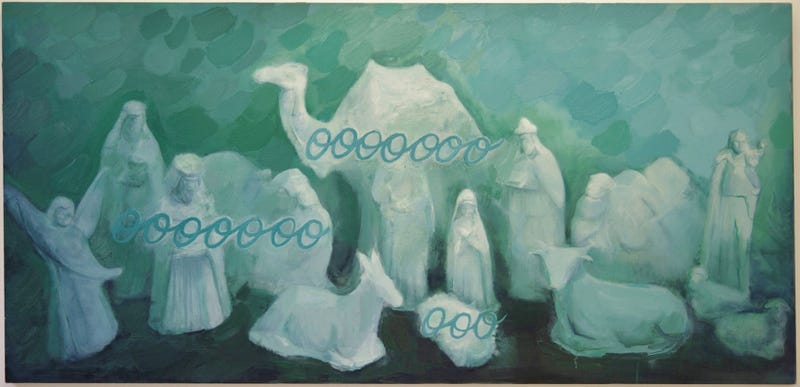
In 2019, painter Ilias Papailiakis curated Streshna’s solo show, HELLO!, a series of works that deal with popular first-person shooter video games and their respective simulations of military combat. Returning to her preoccupation with violence, Streshna does not distance herself from her original western painting references. She however evolves her approach to an of-the-moment reiteration and understanding of warfare. Moving from a historical approach to an anthropological one, the artist illustrates the contemporary representation of war, which is a simulation of one. Recently the debate about whether gaming can be considered an artform came to an end through the judicial ruling in a case against one of the most popular video games Call of Duty, originally designed to emulate scenes of World War II. Known for its particularly realistic depictions of warfare, the game includes the use of a well-known military vehicle, whose trademark owner sued the game’s production company over licensing. The judge declared “If realism is an artistic goal, then the presence in modern warfare games of vehicles employed by actual militaries undoubtedly furthers that goal.[3]” Such a court ruling allows gaming to be considered an artistic form and Streshna to freely access it as yet another artistic reference. Not much was mentioned in the verdict concerning the, apparently not unprecedented, normalization of violence through the realistic depiction of warfare.
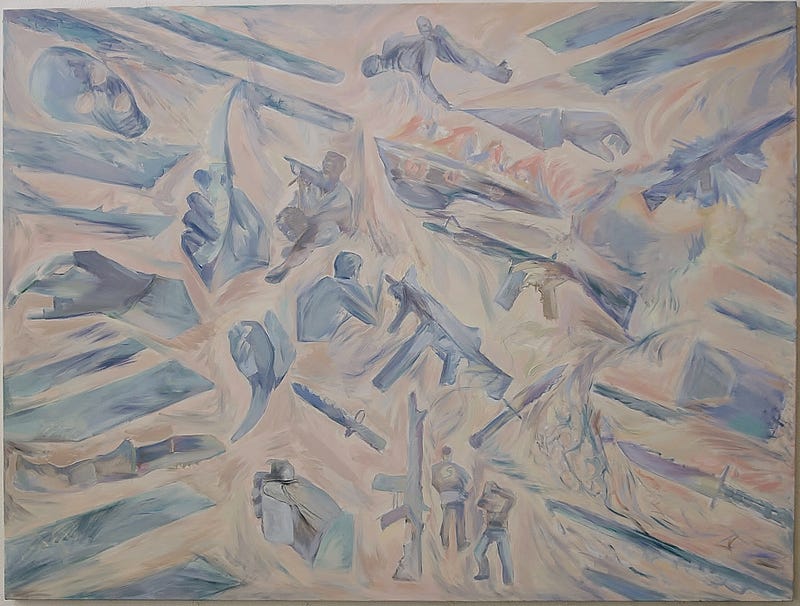
HELLO!, an ironically enthusiastic expression of joyful introduction or perhaps even an absurd order, is a rather interesting evolution for Streshna because she delves further into the mechanisms of war and their capacity to drive grand narratives. Here, she studies not only the manner in which war is presented in order to build collective memory and construct national narration, but its contemporary depiction on a screen through which war is both enacted and witnessed to be as real as possible, to the point of copyright infringement. Undeniably Streshna takes a nod from Jean Baudrillard’s infamous The Gulf War Did Not Take Place[4], who clearly states: “the consequences of what did not take place may be as substantial as those of an historical event. The hypothesis would be that, in the case of the Gulf War as in the case of the events in Eastern Europe, we are no longer dealing with ‘historical events’ but with places of collapse.” Streshna’s paintings therefore have evolved into questioning the notion of reality-construction not through representation but through simulation. She goes as far as drawing a comparison between what has occurred and what we assume has occurred. In the end, this is an existential conundrum fitting to her capacity in abstracted painting and draws a direct parallel with Baudrillard’s idea of collapse in terms of representation.
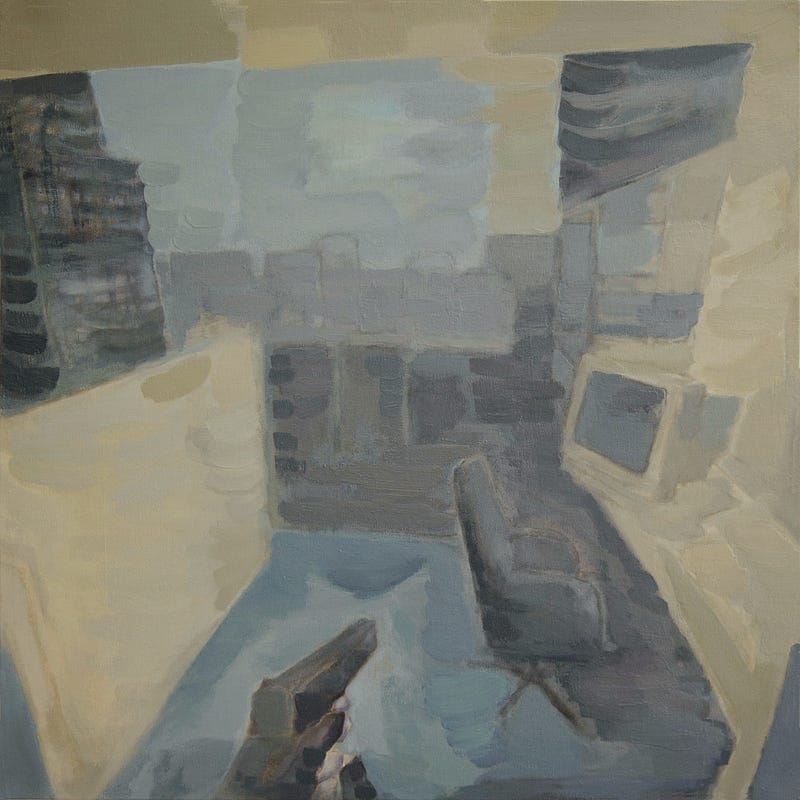
The aforementioned places of collapse trigger my own personal childhood memory and particularly the life-forming experience of watching footage of the Gulf war on television in Greece and asking my parents: “Is this going on right now as we eat our dinner? Are they really bombing cities and killing civilians, as we speak?” I vividly remember the self-imposed and perhaps willing, if not necessary, suspension of disbelief that was presupposed when faced by the all-prevailing image on a TV screen emitting war scenes of world news. I can’t help but wonder if the same was in fact true when Sasha Streshna watched at a tender age the televised collapse of Eastern Europe illustrated by a huge party surrounding the remnants of a wall, somewhere far away from her living room. Today’s dominant abundance of micronarratives, or subjectivities, such as mine or Streshna’s, otherwise the postmodern condition, can be traced back to language. Definitions of words such as justice and injustice become unclear and the foundation of ethics loses credibility, as Lyotard proclaimed in Au juste: Conversations (Just Gaming), (1979). Not unlike the study of linguistics, cultural relativism inevitably leads to dilemmas of accepting two understandings of justice that are by definition incompatible with each other. In fact, the capacity to acknowledge the difference and to attempt to bridge the two different notions, and definitions, of a single translated idea from two different subjectivities, is where the solution may lie. But then again, that is only one subjectivity, mine. As James Elkins mentions in his analysis of Lingchi photography in the essay On the Complicity Between Visual Analysis and Torture: “Formal analysis, compositional analysis, iconographic inventory, narrative reconstruction — all the supposedly preparatory, elementary, rudimentary ways of looking — are far from neutral encounters with visual objects. They are, I think, cold and often cruel dissections of visual objects.[5]”
Evita Tsokanta is an art historian based in Athens who works as a writer, educator and an independent exhibition-maker. She lectures on curatorial practices and contemporary Greek art for the Columbia University Athens Curatorial Summer Program and Arcadia University College of Global Studies. She has contributed to several exhibition catalogues and journals and completed a Goethe Institute writing residency in Leipzig, Halle 14.
*“The die has been cast” (Alea iacta est ) is a variation of a Latin phrase attributed to Julius Ceasar at 49 BCE, as he led his army across the Rubicon river in Northern Italy in defiance of the Senate. Thus, began his long civil war against Pompey and the Optimates.
[1] Lyrics from the song 99 red balloons, by Nena, a western German rock band whose 99 Luftballons (1982) song was translated into English in 1984 after the German original had widespread success in Europe.
[2]Hans Ulrich Obrist, Lives of the Artists, Lives of the Architects, Penguin Random House, 2016.
[3] https://news.artnet.com/art-world/virtual-museum-nintendo-animal-crossing-1824990
[4] Jean Baudrillard, The Gulf War Did Not Take Place, Indiana University Press, Indianapolis, 1995.
[5] James Elkins, On The Complicity Between Visual Analysis and Torture in Representations of Pain in Art and Visual Culture, co-edited with Maria Pia Di Bella, (New York: Routledge, 2012).



